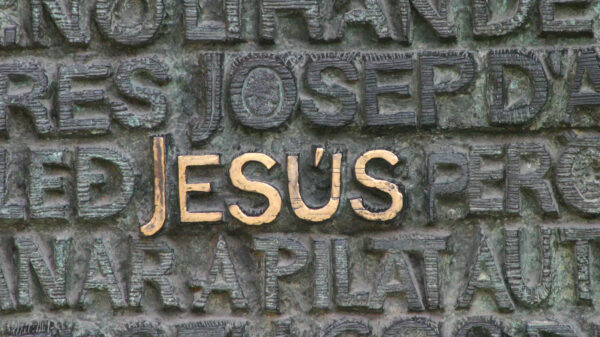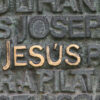
The Gospel of the Hebrews (100-150AD)
The Gospel According to the Hebrews no longer exists, but is mentioned in the writings of Jerome, Origen, Clement of Alexandria, Eusebius and Cyril of Jerusalem. I’m including it in this list of non-canonical texts attributed to Matthew because several of these early Church leaders describe the text as being attributed in this way. Scholars believe it was composed in Egypt in the 2nd century and originally written in Hebrew. It is the most quoted of several “Judeo-Christian” gospels that were used by Jewish-Christian communities. Scholars are uncertain just how many Gospels were used in these Judeo-Christian communities; several have been mentioned by early Church leaders, including The Gospel of the Ebionites, The Gospel of the Nazoreans, and The Gospel of Cerinthus. These may be separate gospels or just different names used to identify the same gospel, based on which community used the text (for purposes of our investigation, we will examine all four texts independently).
Why Isn’t It Considered Reliable?
Although several early Church Fathers described the book as being attributed to Matthew (written in the Hebrew language for use by Hebrew Christians), the quotations available to us from The Gospel of the Hebrews seem to show little or no dependence on the canonical Gospel of Matthew. Eusebius and Origen listed the text among the “disputed writings” that were rejected by some (although accepted by others). From the few quotes available to us, we can see that The Gospel of the Hebrews reflects a theological perspective that would resonate with Jewish believers committed to retaining their deep-seated Jewish beliefs. It is possible that these communities re-shaped the original text to fit their Jewish presuppositions. In addition, the text appears to have shared a verse with The Gospel of Thomas (saying 2), a text that was rejected as heretical by the early Church.
How Does It Corroborate the Life of Jesus?
The few fragments we have concerning The Gospel of the Hebrews clearly recognize Jesus as the “Son of God”, born of a human mother and teaching spiritual truths to a number of disciples. John the Baptist is described as the man who baptized Jesus, and Jesus is recorded teaching about the importance of loving one another.
Where (and Why) Does It Differ from the Reliable Accounts?
There are several places where the fragments of the text seem to reflect the Jewish theology of those who used The Gospel of the Hebrews, rather than the orthodox views represented by the reliable Gospels. As an example, the Gospel of the Hebrews describes Jesus as first appearing to His brother James following the resurrection. This claim would bolster James’ position of leadership in the Jewish community of converts he eventually led in Jerusalem in the 1st century. In addition, The Gospel of the Hebrews reflects an early heresy of the Church called “Adoptionism“. This was a belief among some Hebrew Christians that Jesus was born as a result of a physical union between Mary and Joseph but became divine later at the baptism as the result of His sinless obedience to the Law.
The Gospel of the Nazoraeans (100-180AD)
All that remains of The Gospel to the Nazoraeans are comments from Church leaders such as Hegesippus, Origen, Eusebius and Jerome. The text appears to have been an Aramaic translation of The Gospel of Matthew, with just a small number of variations and additions. It was used by a sect of Jewish-Christians known as Nazoraeans (a Nazarene group of Jewish converts living in Roman occupied Palestine). As I stated earlier, some scholars have argued that The Gospel of the Nazoraeans and The Gospel of the Hebrews are one in the same, while others deny that this is the case.
Why Isn’t It Considered Reliable?
The Gospel of the Nazoraeans is not mentioned in the canonical lists of the Early Church, and is, in fact, not cited until it is described by Hegesippus around 180AD. While its users often attributed it to the Apostle Matthew, it appears to be a late modification with no significant additional information. The content of The Gospel of the Nazoraeans was eventually relegated to the footnotes of the “Zion” edition of Matthew’s Gospel published around 500AD. Early church leaders found nothing worthy of inclusion in the canon of Scripture.
How Does It Corroborate the Life of Jesus?
The Gospel of the Nazoraeans is a largely orthodox affirmation of the life of Jesus. It affirms Jesus’ ministry and the sequential elements of the Biblical narrative, including the fact that Joseph and Mary took Jesus to Egypt as an infant, the fact that Jesus was baptized by John the Baptist and was tempted by the Devil, and the fact that He taught the Sermon on the Mount and the Lord’s Prayer. The Gospel of the Nazoraeans also affirms that Jesus gathered disciples and dispatched them to teach and evangelize. It affirms the passion narrative, including the betrayal of Judas and the trial and crucifixion of Jesus.
Where (and Why) Does It Differ from the Reliable Accounts?
While The Gospel of the Nazoraeans appears to agree (for the most part) with the Gospel of Matthew, scholars have recognized that the Gospel emphasizes the “Jewishness” of Jesus. Many early Church leaders (such as Jerome and Epiphanius) cite the Gospel synonymously with the Gospel of the Hebrews and it appears that The Gospel of Nazoraeans was originally written in Hebrew and used by Jewish-Christian communities.
The Gospel of the Ebionites (120-150AD)
Like The Gospel of the Hebrews and The Gospel of the Nazoraeans, The Gospel of the Ebionites is one of the Jewish-Christian Gospels that was used by early communities of Jewish converts. The Ebionites are probably an offshoot of the Nazarenes who lived east of the Jordan River, near the location where John the Baptist preached and baptized. The Gospel of the Ebionites survives only as a collection of fragments quoted by Epiphanius (the bishop of Salamis who lived from 315-403AD). Because some early Church leaders wrote that the Ebionites used only The Gospel of the Hebrews, a number of scholars believe that The Gospel of the Ebionites and The Gospel of the Hebrews are the same text. But the two texts differ in their accounts of the Baptism of Jesus, causing many scholars to reject this possibility.
Why Isn’t It Considered Reliable?
The Gospel of the Ebionites appears in history later than the canonical Gospels and is not listed in any early record of canonical writings. Epiphanius described the Gospel as incomplete, “falsified and mutilated”. He said that the Ebionites “pervert(ed) the Word of truth into a lie”, reflecting their own unique theology and culture. If Epiphanius is reflecting the view of other early Church leaders, this may very well explain why this late Gospel was excluded from the canon.
How Does It Corroborate the Life of Jesus?
The Gospel of the Ebionites does, however, acknowledge many truths that are described in the canonical Gospels. It describes Jesus as the “Son of God” who had many disciples, including Peter, Matthew, John, James, Andrew, Philip, Bartholomew, James (the son of Alphaeus) and Thomas Thaddaeus, Simon the Zealot and Judas the Iscariot. It also affirms that Peter lived in Capernaum, that Jesus chose his disciples as he walked by the lake of Tiberias, that John the Baptist (son of Zecharias and Elisabeth) performed baptisms in the Jordan River during the days of Herod the King when Caiaphas was high priest, and that God the Father spoke from the heavens at Jesus’ baptism and described Jesus as His “beloved Son, in thee I am well pleased.”
Where (and Why) Does It Differ from the Reliable Accounts?
There are several differing details present in The Gospel of the Ebionites that reflect their presuppositions and theological peculiarities. John the Baptist, for example, is described as eating wild honey but not locusts. Epiphanius wrote that the Ebionites rejected locusts because they were vegetarian. Ebionites also came into conflict with orthodox Christians due to the fact that they were very lenient related to issues of chastity and celibacy. They embraced “adoptionism” (the belief that Jesus took on deity at His baptism) and they rejected the Virgin Birth. The Gospel of the Ebionites excludes the nativity narrative and the description of the virgin conception. As converted Jews, they supposedly rejected the teaching of Paul related to role of the Law in Salvation and The Gospel of the Ebionites (in its entirety) may have reflected this theology.
The Gospel of Cerinthus (120-150AD)
Cerinthus (approximately 100AD) was a heretical Gnostic leader who utilized an altered Gospel to advance his Gnostic theology. The Gospel of Cerinthus was also used by the heretical teacher, Carpocrates, and although the text is lost, it is said to be identical to The Gospel of the Ebionites.
Why Isn’t It Considered Reliable?
The early Church Fathers identified Cerinthus as a heretic due to the fact that he followed the Jewish Law, denied that God made the physical world, and denied that Jesus was God incarnate. Irenaeus included an account of Cerinthus in his work, “Against Heresies” (written around 170AD). Whatever text Cerinthus may have used with his followers, it was apparently heretical in the eyes of the canonical eyewitnesses. Early Church tradition reports that John the Evangelist so despised Cerinthus as a heretic that he refused to be seen in the same bath house. This same tradition reports that John wrote The Gospel of John to record the truth and correct the false teaching of Cerinthus.
How Does It Corroborate the Life of Jesus?
Without an extant Gospel that can be examined for similarities, it is not possible for us to determine how (if at all) The Gospel of Cerinthus may have affirmed details of the canonical Gospels.
Where (and Why) Does It Differ from the Reliable Accounts?
We can only speculate as to how The Gospel of Cerinthus may have differed from the canonical Gospels. Cerinthus denied the divinity of Jesus, so the statements made by Jesus, the manner in which He was worshipped as God and the miracles He performed to prove His Deity may have been minimized. Cerinthus believed that the “Christ” came to Jesus at His baptism, stayed with Him throughout His ministry as a guide, and then left Him at the crucifixion. Cerinthus’ Gospel may have reflected these theology beliefs.
The Infancy Gospel of Pseudo-Matthew (750-850AD)
This text is yet another example of Apocrypha which attempts to fill in details of Jesus’ childhood missing from the canonical Gospels. Like The Arabic Gospel of the Infancy, this document borrows heavily from the earlier Infancy Gospel of James (for material related to the Virgin Mary) and Infancy Gospel of Thomas (for material related to the childhood of Jesus). It also provides additional information (from an unknown source) related to Joseph, Mary and Jesus’ flight into Egypt. In ancient times, this document was known as The Book About the Origin of the Blessed Mary and the Childhood of the Savior. It appears to be a collection of fragments or excerpts, beginning with what purports to be a letter from Jerome to Bishop Comatius and Bishop Heliodorus in which the bishops attempt to validate the earlier apocryphal Infancy Gospels by claiming this text was recently discovered and written by the Apostle Matthew in Hebrew. Scholars reject the authenticity of these opening letters, however.
Why Isn’t It Considered Reliable?
In addition to the fact scholars reject the “authenticating” letters prefacing the text, scholars have also determined the excerpts for this text were collected and assembled between the 8th and 9th centuries, making this document an exceedingly late apocryphal text. It is based on two known pieces of fiction (The Infancy Gospel of James and The Infancy Gospel of Thomas) and is also very similar to The Arabic Gospel of the Infancy, another known late, fraudulent apocryphal document.
How Does It Corroborate the Life of Jesus?
While much of The Infancy Gospel of Pseudo-Matthew concerns itself with the flight to Egypt and Jesus’ life as a child (areas that are not covered in the canonical Gospels), there is a great deal of information recognizing and affirming the truth of the canonical Gospels, particularly related to the nativity narrative. Mary is again described as a virgin, visited by an angel who told her about the miraculous coming of Jesus. Joseph discovered her pregnancy but is also then visited by an angel. As in the canonical Gospels, Joseph and Mary return to Bethlehem for the census, and a star miraculously marks the event of Jesus’ birth. After His birth, Mary places Jesus in the stall of a stable and “Symeon” and Anna later adore Him. The persecution of Herod and the murdering of the children is repeated here, and an angel warns Joseph as in the Biblical narrative. Once again, the Holy Family escapes to Egypt.
Where (and Why) Does It Differ from the Reliable Accounts?
Like other late documents of this type, The Infancy Gospel of Pseudo-Matthew venerates Mary to an extraordinary degree, borrowing from The Infancy Gospel of James to describe her childhood and dedication. Interestingly, the fictitious details surrounding the flight into Egypt became an important part of the mythology of the early Coptic Church in Egypt, as it describes several stops along the way with a variety of events recorded throughout Egypt. The text also had popular interest and was included in later editions of legendary stories (like the 13th century Golden Legend. Other texts were also born from the section related to Mary (like the Libellus de Nativitate Sanctae Mariae), thus extending the legends related to the veneration of Mary that have become an important part of the Roman Catholic tradition.
The ancient non-canonical texts, although attributed to Matthew, the same man who wrote a true, reliable Gospel account, are late, fictional narratives. Share on X
These ancient non-canonical texts, although attributed to Matthew, the same man who wrote a true, reliable Gospel account, are late, fictional narratives. When examined under the criteria we use to determine eyewitness reliability, they fail the test. The four canonical Gospels (Mark, Matthew, Luke and John) are still the earliest reliable record of Jesus, written within the lifetimes of the eyewitnesses who knew Jesus personally.

J. Warner Wallace is a Dateline featured Cold-Case Detective, Senior Fellow at the Colson Center for Christian Worldview, Adj. Professor of Christian Apologetics at Talbot School of Theology, Biola University, author of Cold-Case Christianity, God’s Crime Scene, and Forensic Faith, and creator of the Case Makers Academy for kids.
Subscribe to J. Warner’s Daily Email
J. Warner Wallace is a Dateline featured cold-case homicide detective, popular national speaker and best-selling author. He continues to consult on cold-case investigations while serving as a Senior Fellow at the Colson Center for Christian Worldview. He is also an Adj. Professor of Christian Apologetics at Talbot School of Theology, Biola University, and a faculty member at Summit Ministries. He holds a BA in Design (from CSULB), an MA in Architecture (from UCLA), and an MA in Theological Studies (from Gateway Seminary).
































